The main difference between Thai curry and Indian curry is that Thai curries have a bright flavor, vibrant color, and a thinner consistency. In contrast, Indian curries are packed with spices, highly aromatic, and usually have a thick, gravy-like consistency.
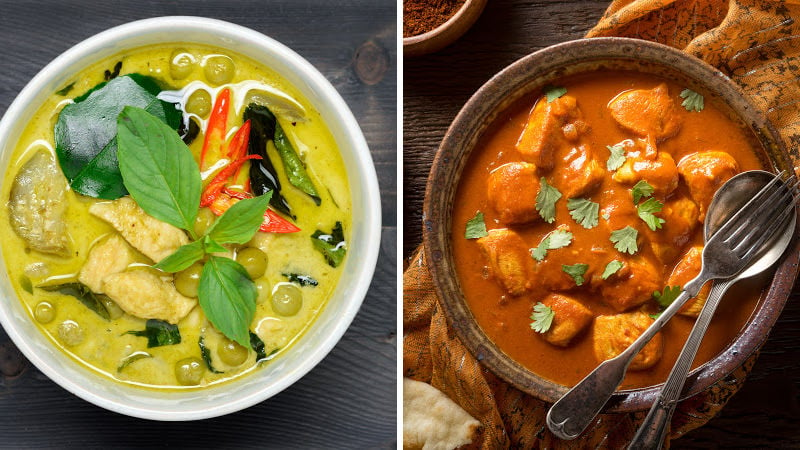
If you love curry, you'll know that Thai and Indian curries are some of the best in the world. While Thai curries use herbs and vegetables blended into curry paste as a base, Indian curries use a mix of spices for flavor and aroma.
Curry in both Thailand and India is delicious, diverse, fragrant, and flavorful. But they have some subtle differences. Below, you'll find out their differences and see a summary table comparing Indian and Thai curry.
Table of Contents
- What's the difference between Thai and Indian curries?
- What ingredients are used in Thai curry and Indian curry?
- How are Indian and Thai curries different?
- How are Thai and Indian curries the same?
- Summary Table Comparing Indian and Thai Curry
- Does Thai curry taste like Indian curry?
- Our Favorite Indian Curries
- Our Favorite Thai Curries
- Quick Curry Tips
- Final Words
What's the difference between Thai and Indian curries?
Thai curries usually start with fresh ingredients that are blended into a curry paste. They're packed with flavor, have a vibrant color, and can range from runny to thick in texture. Indian curries often begin by briefly toasting spices, before simmering additional meat or vegetables with ghee, cream, or yogurt. They're rich, aromatic, and usually have a thick, gravy-like texture.
Keep in mind this article makes some generalizations to keep things simple. Curries from both countries vary massively; even local regions have their own angle on how recipes should taste.
Hat Tip: A special shout-out to our friends at the Spice Factory for sending some amazing spices our way. They were helpful for this comparison article, but the team was feeling sluggish after multiple curries in one day!
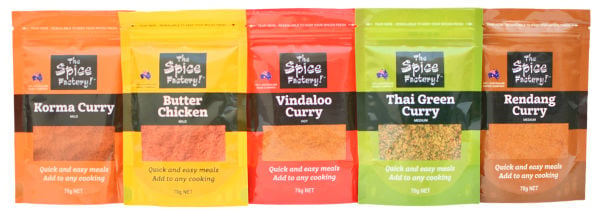
What ingredients are used in Thai curry and Indian curry?
Thai: Lemongrass, chili, kaffir lime, cilantro, galangal, ginger, garlic, tamarind paste, and shrimp paste are often used to make a paste. It gets sauteed with oil before extra ingredients are added.
Indian: Indian cooks call on a huge range of dried spices in their dishes; popular choices include cumin, turmeric, cardamom, fenugreek, mustard seeds, Garam Masala (a blend), and paprika.
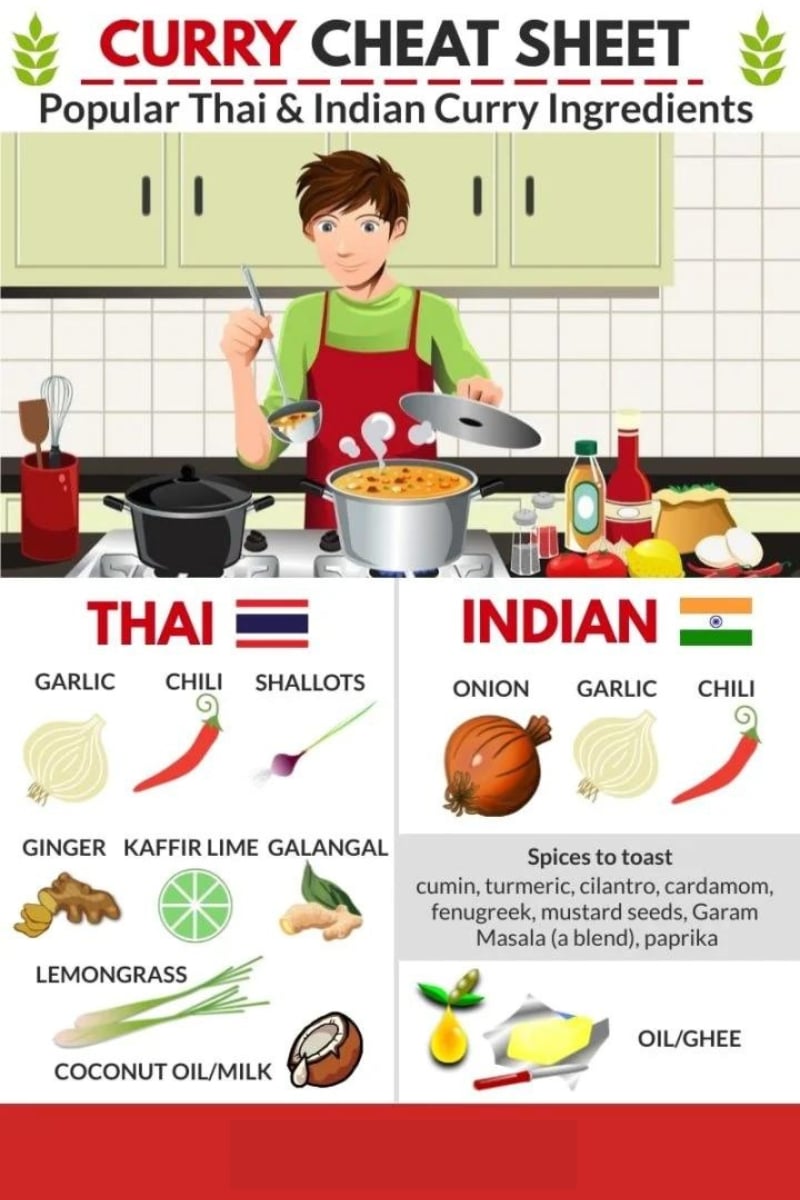
Related reading: Japanese Vs Indian Curry - a useful comparison.
How are Indian and Thai curries different?
1. Indian curries are usually thicker.
Many Indian curries have a thick, gravy-like consistency. Ingredients like cream, yogurt, potato, and tomato all help thicken any liquid.
On the other hand, popular Thai green or yellow curry will often have a soupy texture. But there are also massaman or lamb curries which are served luxuriously thick.
2. Each has a unique flavor profile.
While Indian curries can range widely in flavor, they tend to have a common group of spices that are favorites. Turmeric, brown mustard seeds, Garam Masala, cumin, and paprika produce rich, hearty dishes that balance spice flavor profiles with expert precision.
Thai food focuses on using fresh ingredients that invigorate the dish. Ingredients like kaffir lime, ginger, and lemongrass create edgy dishes with a bright, citrusy feel.
3. Thai curries use less dairy.
An Indian curry will often use ghee, butter, or oil to toast the spices at the start of cooking. While this fat adds a rich, velvety texture to the curry, it also acts as a transport vehicle for the spices – ensuring every piece of meat or vegetable gets coated in mouth-watering spices. Cream and yogurt help develop a thicker, creamier meal and also tame the spiciness.
Authentic restaurants in Thailand prefer using peanut oil initially and simmering their curries in coconut milk or stock. This style of cooking results in lighter dishes. Meals like green curry and Khao Soi can get fiery hot without dairy ingredients to help reduce the heat.
4. Thai chefs rely heavily on bright flavors like lemongrass and galangal.
While Indian cookery isn’t a stranger to ingredients like lemongrass or galangal, their use isn’t as widespread. Thai food uses them extensively, adding a pop of flavor to Tom Yum and Tom Kha soups. They’re also added to red curry, green curry, massaman curry, and much more.
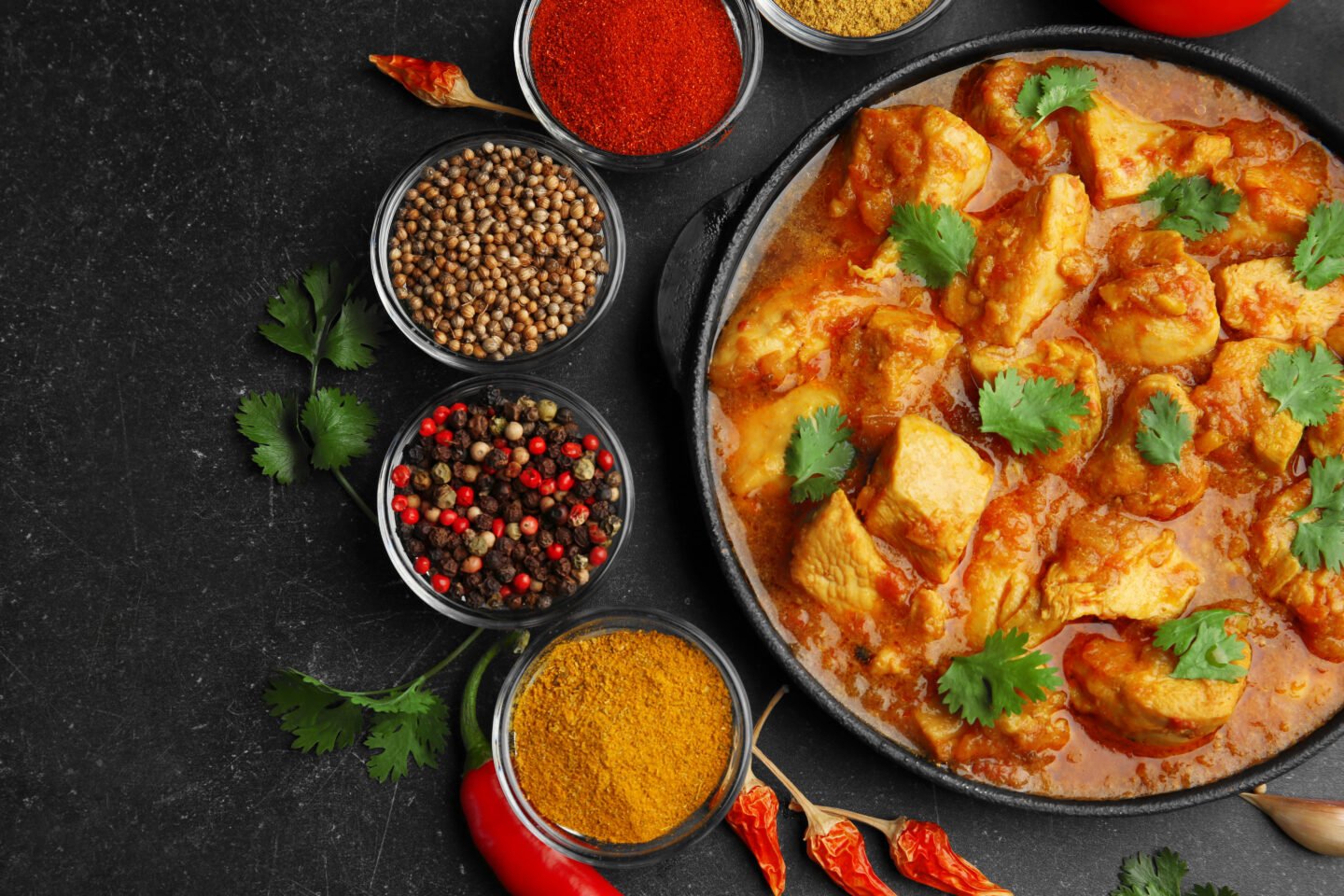
5. Indian curries start with dry spices.
A huge number of Indian curries start with toasting whole spices until fragrant. Few cuisines can claim to have a kitchen that has aromas as good as an Indian one. Thai chefs prefer to create a paste from various herbs, spices, and other fresh ingredients.
6. Indian curry often comes with basmati rice.
Indians love to serve their curries with basmati rice, an excellent choice for soaking up the sauce. The rice also brings a subtle pandan flavor that helps balance rich, spicy curries.
Thai curry is more likely to be served with jasmine rice which fills the air with its unique fragrance. The rice granules are stickier than basmati, making it easier to keep everything on your fork or spoon.
Learn more about the difference between Basmati and Jasmine rice here.
Another popular side dish served with Thai curry is coconut rice. This is long-grain rice that gets soaked in coconut milk. It’s deliciously sweet and provides relief from a super-hot curry.
7. Indian curries are never served with noodles.
As we mentioned, Indian curries are often served with basmati rice. Other popular sides include roti, naan, paratha, and chapati, or a hearty bowl of urad daal.
Thai curries may come with noodles ranging in thickness. You won’t see Indian restaurants serving noodles.
8. Cilantro seeds are the domain of an Indian curry.
Indian curries will often include toasted cilantro (coriander) seeds. They provide a sweet and earthy flavor with a little lemony tartness. Thai cooking doesn’t use much cilantro seed in curries; instead, the cilantro leaves are sometimes used as a garnish.
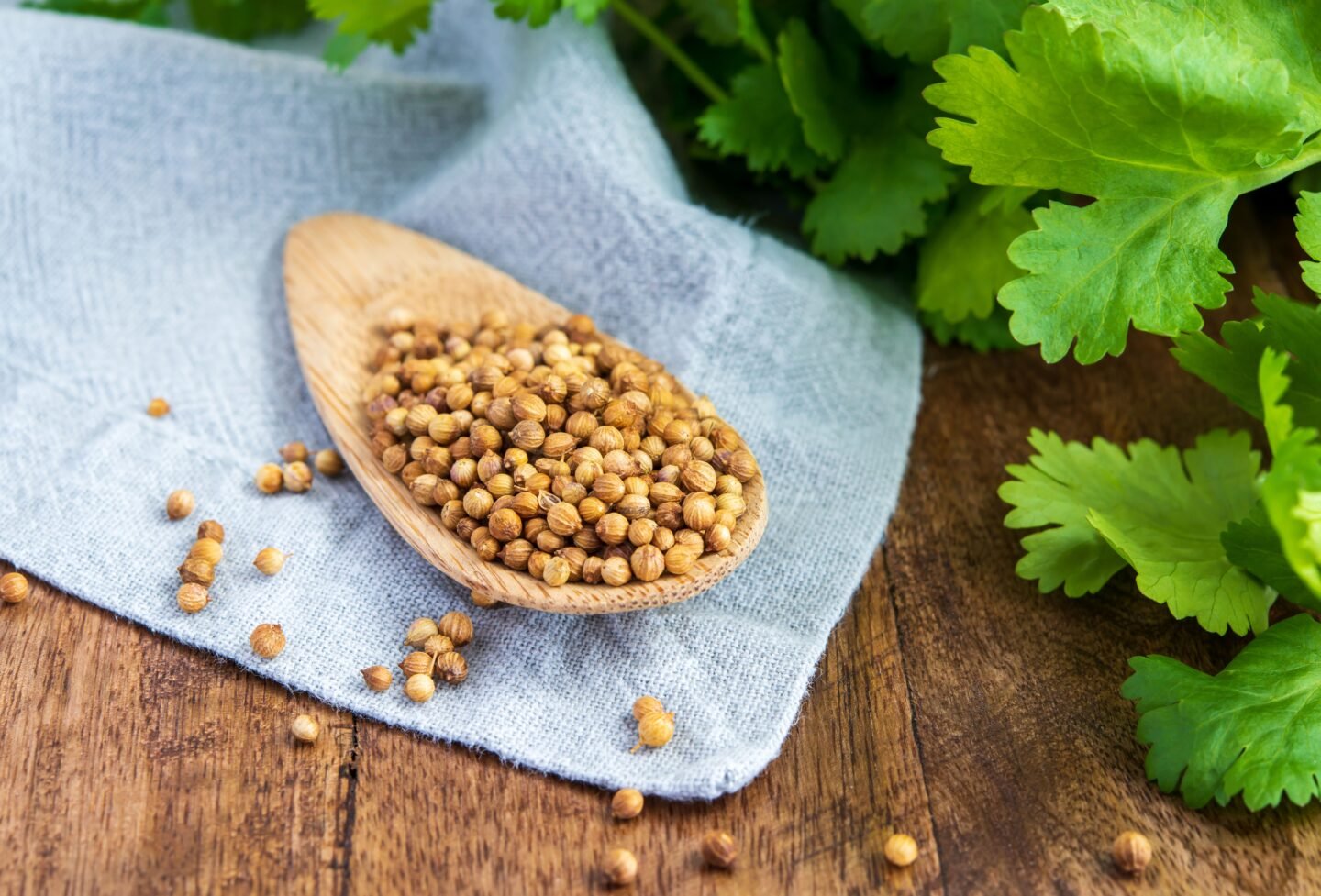
Related reading: Jalfrezi vs vindaloo - how do they differ?
How are Thai and Indian curries the same?
1. Each cuisine can vary wildly in heat.
For those who don’t like hot food, you’ll find that Thai or Indian cuisines have a curry for any palate. Levels of heat will vary depending on who is doing the cooking, so it's best to check with the restaurant if you’re eating out. They’ll usually adjust the spiciness to suit.
There are some general guidelines on which curries are hotter than others. Check out the table below for some guidance.
| Heat Level | Thai Curry | Indian Curry |
|---|---|---|
| Mild | Lamb curry, massaman, panang, yellow | Korma, pasanda, malai kofta, butter chicken, tikka masala |
| Hot | Green, red | Phaal, vindaloo, Kashmiri chicken, kadai paneer |
2. Neither curry type relies heavily on curry leaves.
You’d expect that the curry leaf would be the building block for any curry. It is, after all, called a curry. But Thai chefs prefer to use lemongrass or kaffir lime to brighten the dish. Indian curries will use curry leaves in some recipes, but they are often not used at all.
3. Both are easy to find.
Whichever type of curry you prefer, there's usually a restaurant serving it up nearby. If dining at home is your preference, the ingredients are easy to find or you can use a packet mix to make life easy.
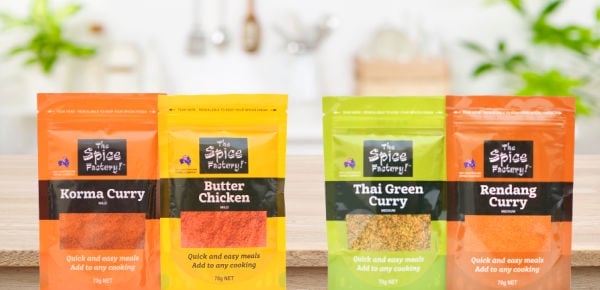
Summary Table Comparing Indian and Thai Curry
Are you scratching your head at this point trying to work out how these two curry varieties differ? Check out this table which covers the major differences.
| Factor | Thai Curry | Indian Curry |
|---|---|---|
| Consistency | Thick or soup-like | Usually thick like gravy |
| Popular spices | Lemongrass, chili, galangal, ginger, garlic, tamarind paste | Diverse range of spices including turmeric, brown mustard seeds, Garam Masala, cumin, and paprika |
| Flavor | Spicy, aromatic, more focus on fresh ingredients | Earthy, spicy, more focus on aromatic spice combinations |
| Popular meats used | Prawn, chicken, beef, pork, fish, tofu | Chicken, lamb, fish |
| Type of rice used | Jasmine rice, coconut rice | Long-grain basmati rice |
| Popular vegetables | Carrots, broccoli, potato, bell pepper, onion | Cauliflower, potato, spinach, peas, tomatoes |
| Spice levels | Mild to very hot | Mild to very hot |
| How is it made | Often a paste in sauteed with additional ingredients | Initially spices are toasted before additional ingredients are added |
Does Thai curry taste like Indian curry?
While both types of curry share some common ingredients, Indian curries are often rich and luxurious with an impeccable balance of spices. Meanwhile, Thai curries are brighter and have more emphasis on fresh ingredients.
Our Favorite Indian Curries
Butter chicken: A creamy, tomato-based sauce combined with tender chicken. It’s a mild dish that can be slightly sweet. Some get this curry mixed up with tikka masala so check out our comparison of tikka masala and butter chicken.
Saag paneer: This is a good option if you like the sound of leafy greens cooked with paneer cheese in a luxurious sauce. It’s another good choice for people that prefer mild food. Discover how saag and palak are different in this article.
Beef vindaloo: Ingredients like chili peppers, paprika, garlic, turmeric, and garam masala combine to make a spicy hot dish. When combined with tender, slow-cooked beef the result is a flavor-packed delicious meal.
Also worth trying: Lamb korma, malai kofta, dhansak curry.
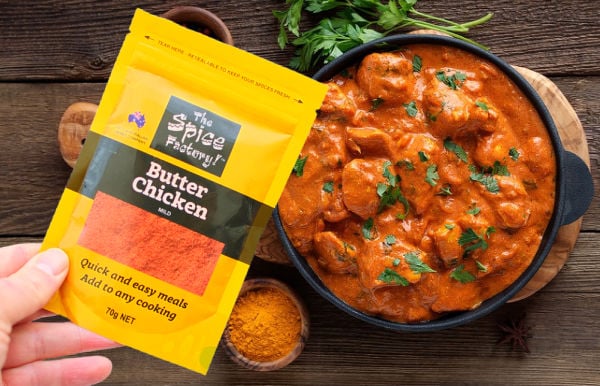
Our Favorite Thai Curries
Yellow curry: Generally mild in heat, this curry is perfect for anyone who enjoys creamy curry with plenty of flavors. It’s perfect with fish, chicken, pork, beef, or tofu.
Green curry: The green curry has the potential to get really hot, especially if you’re in Thailand! It’s bursting with flavor thanks to punchy ingredients like kaffir lime leaves, Thai basil, shrimp paste, and cumin seeds.
Beef rendang: Rendang involves slowly cooking beef in coconut milk, herbs, and spices. The final result is caramelized meat that has developed a rich flavor.
Also worth trying: massaman curry, coconut chicken curry.
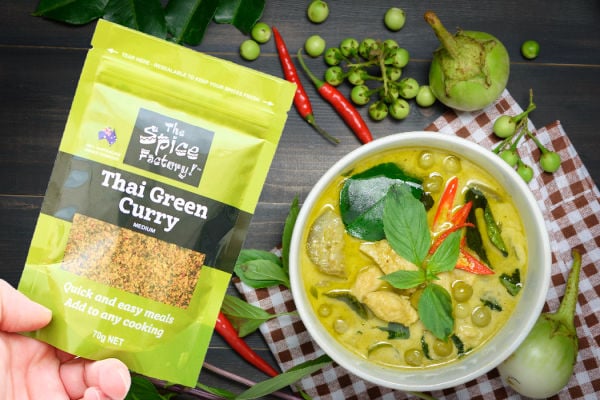
Quick Curry Tips
- Creamy elements like yogurt and cream help reduce the heat in a recipe.
- Don’t expect every green curry to be fiery hot and the yellow ones to all be mild. They will vary depending on the person that cooks them.
- Drinking water isn’t the best way to get relief from a spicy meal; milk or a soothing mango lassi will do a better job.
Related reading:
What are the best alternatives to korma paste?
How can I replace khoya in cooking?
How do I describe the taste of amla.
What's a tasty alternative to laksa paste?
Final Words
India and Thailand are both responsible for some of the best food on the planet, especially their curries. Is it your first time trying these cuisines? Maybe you’re unsure how Thai and Indian curries differ. Keep in mind that both curries have dishes that are mild through to uncomfortably hot.
Indian sauces are often thick and rich with impressive depth of flavor. The Thai version of curry tends to be runnier, brighter, and uses more fresh ingredients. Most importantly, they’re both delicious.

Leave a Reply